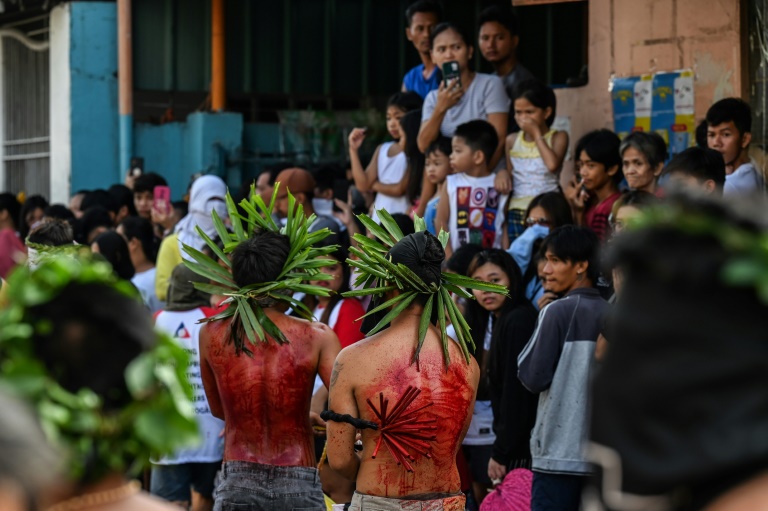Catholic zealots in the Philippines re-enacting the last moments of Jesus Christ were nailed to wooden crosses while others whipped themselves bloody in extreme displays of religious devotion on Good Friday.
While most Filipinos went to church or spent the holiday with family, thousands gathered in villages around San Fernando city, north of Manila, to watch men punish themselves in a bid to atone for their sins or seek miracles from God.
Dozens of bare-chested flagellants wearing black shrouds and crowns made of vines walked barefoot through dusty, narrow streets, rhythmically flogging their backs with strips of bamboo tied to ropes, their blood soaking the top of their trousers and spattering onlookers.
Some lay face down on the ground to be whipped and beaten by others, razor blades sometimes used to draw blood.
“This is for my son, an epileptic,” said Joel Yutoc, who has his 13-year-old son’s name tattooed across his chest.
Yutoc, 31, said his son had not had seizures in the eight years since he began taking part in the Good Friday floggings.
The whippings are the opening act of street plays performed by devout residents.
In San Juan village, a short, wiry man with wild, white hair playing the role of Jesus Christ and two others were dragged by neighbours dressed as Roman centurions to a raised mound where wooden crosses lay on the ground.
As spectators filmed on their mobile phones, three-inch nails were driven into the men’s palms and the crosses were hoisted upright.
Several minutes later the crosses were lowered to the ground and the nails pulled out.
“I will keep doing this while I’m alive, for as long as my body is able to do it. That is my vow,” said retired fisherman Wilfredo Salvador, 67, who began playing the role of Jesus Christ in the mock crucifixions 16 years ago following a mental breakdown.
“This is nothing. Sometimes it heals after a day and I am able to wash dishes and bathe,” Salvador said of his wounds.
San Juan homemaker Marilyn Lovite, 41, said she watches the gruesome re-enactment every year to “learn about the suffering of Christ”.
“If you were to merely read it in the Bible you would not really understand. In action it is clearer for us to see how he suffered for us,” the mother-of-four said.
Ten people were nailed or strung up on crosses at three crucifixion sites, San Fernando city councillor Reginaldo David told reporters.
At the biggest event, veteran performer Ruben Enaje, 63, had his hands and feet nailed to a cross for the 35th time in his role as Jesus Christ.
Enaje remained nailed up for more than 10 minutes as storm clouds gathered overhead. It began to rain as he was carried on a stretcher to a medical tent where his wounds were bandaged.
“I feel no pain in my hands but my body as a whole feels sore,” Enaje said.
“The Passion Play was longer this year because we lengthened the script. Maybe that was why my body feels sore.”
Enaje said this year might be his last appearance as Jesus.
“I can’t say if I will still be able to do it again next year because my body feels like it is about to give in,” he said.
The extreme acts are frowned upon by the Catholic Church in the Philippines and health experts.
The Philippine health department urged the public this week to “avoid acts or rites that lead to physical wounds and injuries”.
“We join the pastoral guidance of our faith leaders, guiding all towards religious practices that are safe and healthy,” it said in a statement.
But for devotees like 23-year-old Ian Bautista, who has been taking part in the floggings since he was 15 and is one of four flagellants in his family, the suffering was for a good cause.
“It’s for my mother,” Bautista said, explaining that she had surgery for an ovarian cyst on Monday and that he believed taking part would help her recovery.
“It’s painful but I will do this until my body gives up.”
AFP

AFP







